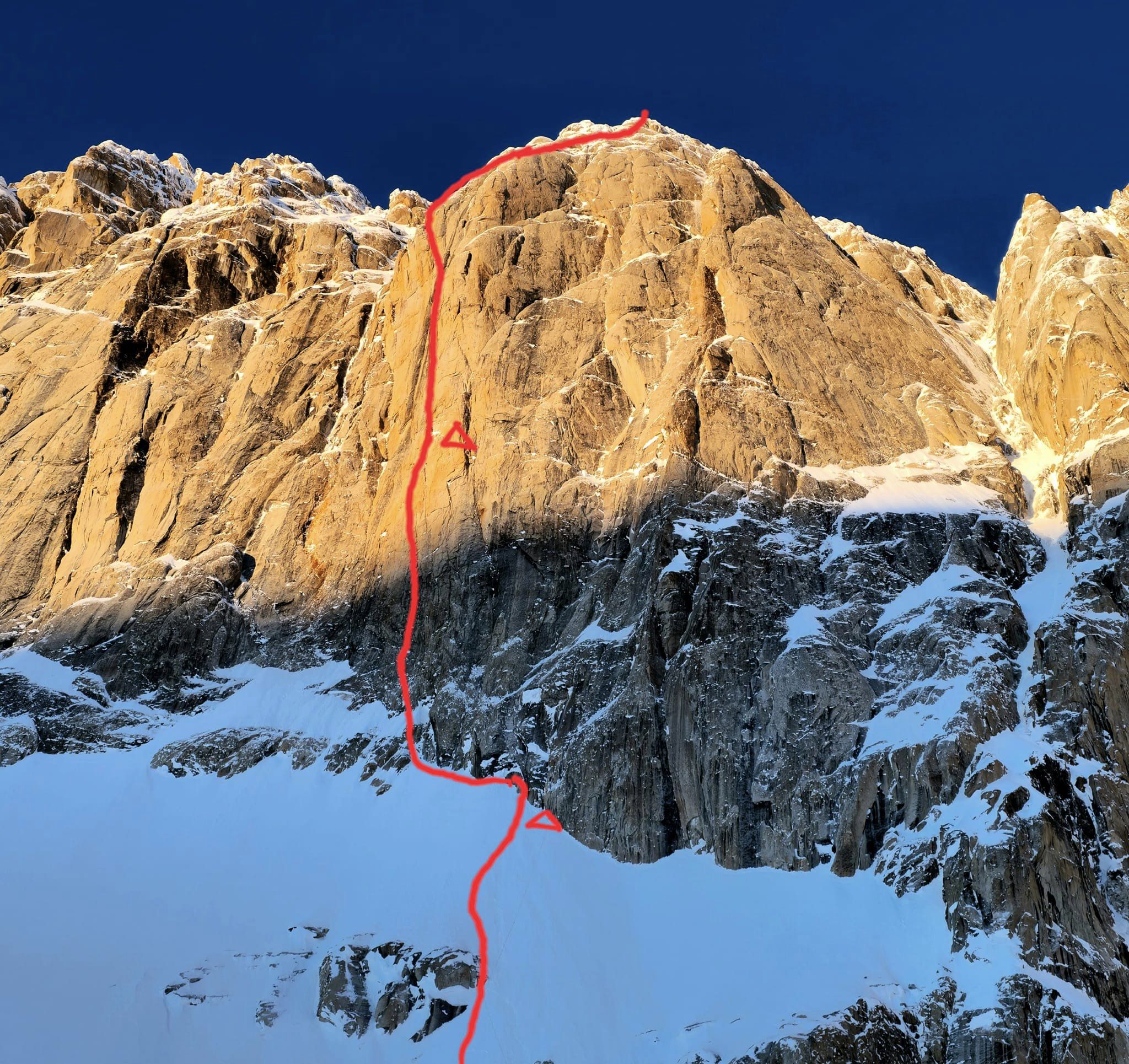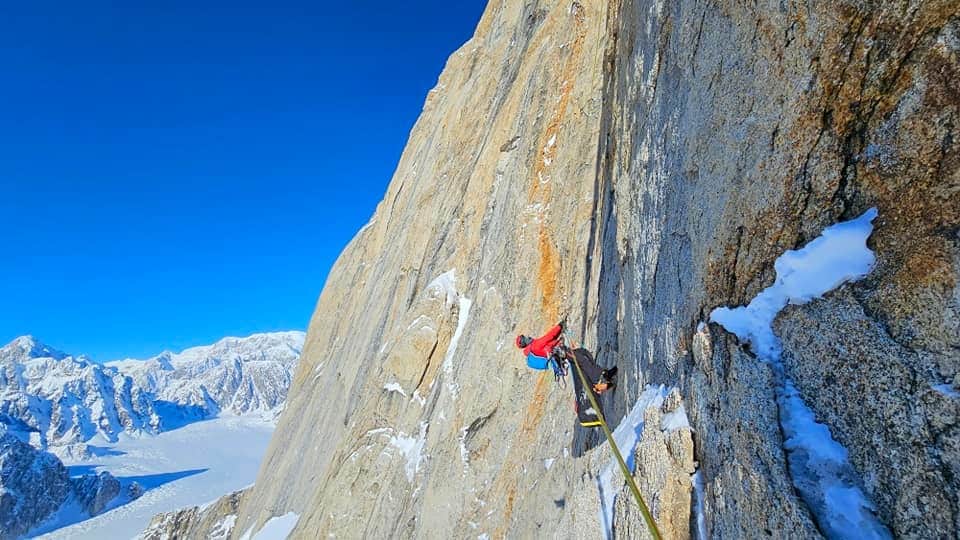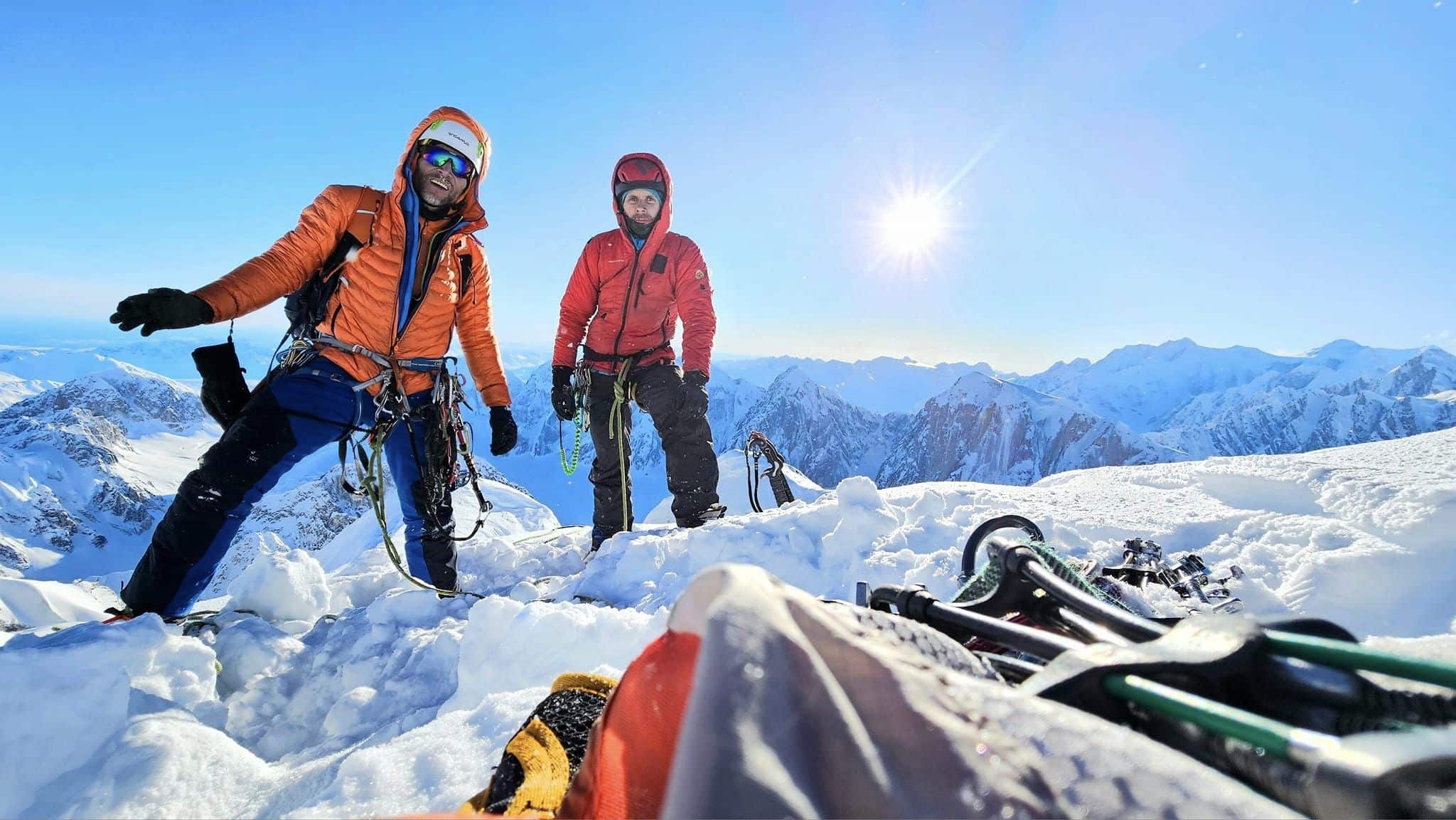In Alaska’s Denali National Park, from February 28th to March 8th, 2024, Polish climbers Paweł Hałdaś and Marcin Tomaszewski pioneered a new route on the vast south face of Moose’s Tooth. After ten days of ascent, the team named the line “Cold War” (980m, A3, M5+), in reference to the long struggle against freezing temperatures and frostbite they had to endure along the climb.
Going climbing in Alaska in the heart of winter – now there’s a peculiar idea! Yet, it’s precisely this idea that crossed the minds of Paweł Hałdaś and Marcin Tomaszewski, also known as “Yeti”, when deciding on their future vacation plans. But fret not, these two Poles are, to put it mildly, what we call seasoned mountaineers. With steely gazes and chiseled features, they resemble more ice axe warriors than crag climbers. Accustomed to “challenging, technical, and time-consuming terrain”, here they are in their field of predilection.
By completing this first winter ascent on one of the peaks of the Moose’s Tooth massif, the team undoubtedly marks a new major achievement in the world of big wall climbing. Moreover, this latest feat is not their first show of strength. Last year, in February 2023, they opened “FRAM” (700m, A3, M5), a new route on the west coast of Greenland, blending exploration and commitment. With this accomplishment, they achieved the feat of being the first to climb a wall of such magnitude in Greenland during the winter season.
When embracing Adventure
rhymes with frostbites
Although a few thousand kilometers apart, this year’s objective was, on paper, not all that different. A big face of rotten rock, not much information on the web and cold, lots of cold. As Marcin Tomaszewski explains on his Facebook account, “the media was silent on the subject of winter bigwall ascents in Alaska. So we decided to let go, take it easy and not focus on it but just open ourselves up to the adventure.”
Open to adventure, that’s a fine philosophy. Except that here, adventure rhymes with frostbites. Strangely enough, the freedom to choose one’s line as desired—which Marcin compares to picking a cookie at the confectionery as a child—suddenly feels much less weightless. Don’t be misled by the casual tone of the report; one thing is for certain, on this south face of Moose’s Tooth, business couldn’t be more serious.
A battle with
winter and the wall
Right from the first morning, on the approach, the tone is set. Tomaszewski recounts : “We set the alarm clock for 6 a.m., left the tent briskly at 7 a.m. only to return to it even more briskly less than a minute later! To our still warm sleeping bags. It was really cold.”
The alarm clock is set back to wait for milder temperatures. The two Poles then took a whole day to climb the 60/70° snow slopes that mark the start of the route, huge hauling bags on their backs. They then set up their first portaledge bivouac.
The very next day, they tackle the initial pitches. According to Marcin, it was at this point that “the battle with winter and, secondarily, with the wall, began.”
-30°C during the day
Far from the free climbing, progress here requires method and imagination. Using classic pitons, bird beaks, cams and ladders, Marcin and Paweł employ all their artifices to ascend through the systems of cracks clogged with sand and rocks.
As night falls, they must then ascend the portaledge, set up the bivouac on a narrow terrace, struggle to light the gasoline stove, and melt the scant snow willing to warm up.
if I lose contact with my toes or fingers
no matter where I am
I stop
The cold is always lying in ambush, never letting them out of its grasp. Temperatures approach -30°C during the day. Tomaszsewski explains: ” It was vital to tuck the removed gloves under one’s jacket so that they did not turn into an icicle in an instant. As on my recent expeditions, I applied the principle that if I lose contact with my toes or fingers I stop where I am and warm up as long as it takes. Thanks to this method, during my last expeditions both I and my partners did not suffer even the slightest frostbite.”
Two rooms
two moods
Constantly, the team has to contend with a series of snowfalls, which in turn release deluge after deluge of powder – the infamous spindrifts. The two friends alternate their positions at the head of the rope. In the fury of the elements, the question arises as to whether the leader or the belayer is in the best position.
The belayer, motionless, lets himself be enveloped in winter’s frozen embrace. The longer it goes on, the frostier his down jacket becomes. From time to time, he raises his head to look at his leader, revealing a face that seems to have lost its blood.
A few rope lengths away, the leader no longer feels the cold, but has to fight hand-to-hand with the wall. Meter by meter, point by point, he advances without looking back. Two rooms, two moods.
A final breakthrough
And so, halfway between a street fight and trench warfare, the Poles continued their breakthrough. On the tenth day, March 8, 2024, on the occasion of International Women’s Rights Day, they decided to lead a final assault to the summit.
“On that day the weather was on our side. Over the course of six full pitches we tackled both aid and free climbing parts, there was some firn and snow and finally… the summit. Paweł got there first. I reached my partner, who was sitting smiling in the snow. – You can’t get any higher! – He shouted. All around us there were the Alaskan mountains below, empty at this time of year. It was dazzling !” reports Marcin.
Sound the victory bell for the duo! On their return from the expedition, the two Poles meet in a local bar to drink beer and eat pizza, in order to make up for the deficiencies imposed by the freeze-dried food. Afterwards, Marcin Tomaszewski admits: ” we were very lucky, but I also know that this luck wouldn’t have worked if we hadn’t put all our heart into this climb.”
For him, the success of this new route – which he considers harder than the one opened up in Greenland – is down to a fine blend of determination, technique and, it has to be said, a touch of naivety. A method he associates with a period of life seemingly far removed from mountaineering: childhood.
The childhood method
At the end of his account, the Pole explains : ” Moments like this confirm to me how important it is to be aware, to wisely lead your human reflexes and thoughts astray just to look at the world from a different angle. You have to go into the wall without looking down, just like a child who, fighting a fear of heights high on a ladder, doesn’t look under their feet. The longer I climb, the more I have humility and affection for people as well as self-confidence, which is also important in our human relationships. I smile more often and am able to give more of myself to loved ones and beyond. To what else? I don’t know yet, but I will certainly find out. “
harder, purer
Half-warrior, half-child, half-eyeti, Marcin Tomaszewski is definitely polymorphous. His latest feat with Pawel Haldas, with whom he forms a fascinating team, bears witness to this. A fascination for the method, the determination and the characters, the antithesis of the marketable mountain found in our Alps. A style that disregards the faster, lighter, more Instagrammable to focus solely on the essential: the hardest and purest.











